高一英语必修一Unit-3-Reading-Journey-down-the-Mekong-(阅读课
- 格式:ppt
- 大小:1.90 MB
- 文档页数:21
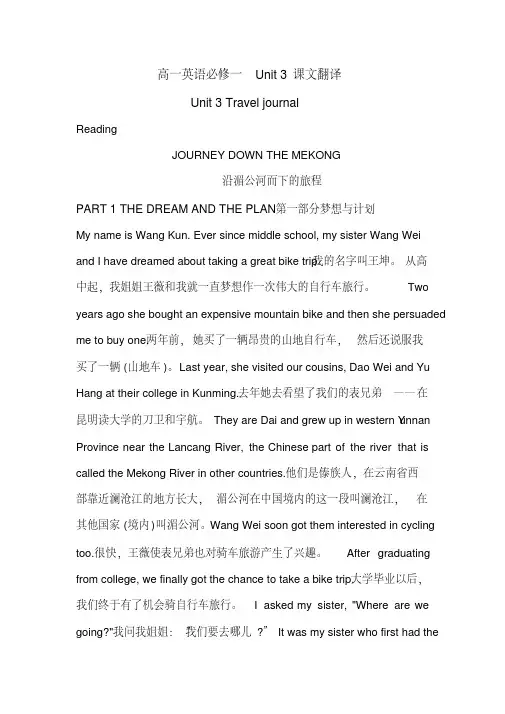
高一英语必修一Unit 3课文翻译Unit 3 Travel journalReadingJOURNEY DOWN THE MEKONG沿湄公河而下的旅程PART 1 THE DREAM AND THE PLAN第一部分梦想与计划My name is Wang Kun. Ever since middle school, my sister Wang Weiand I have dreamed about taking a great bike trip.我的名字叫王坤。
从高中起,我姐姐王薇和我就一直梦想作一次伟大的自行车旅行。
Two years ago she bought an expensive mountain bike and then she persuaded me to buy one.两年前,她买了一辆昂贵的山地自行车,然后还说服我买了一辆(山地车)。
Last year, she visited our cousins, Dao Wei and Yu Hang at their college in Kunming.去年她去看望了我们的表兄弟——在昆明读大学的刀卫和宇航。
They are Dai and grew up in western Y unnan Province near the Lancang River, the Chinese part of the river that is called the Mekong River in other countries.他们是傣族人,在云南省西部靠近澜沧江的地方长大,湄公河在中国境内的这一段叫澜沧江,在其他国家(境内)叫湄公河。
Wang Wei soon got them interested in cycling too.很快,王薇使表兄弟也对骑车旅游产生了兴趣。
After graduating from college, we finally got the chance to take a bike trip.大学毕业以后,我们终于有了机会骑自行车旅行。

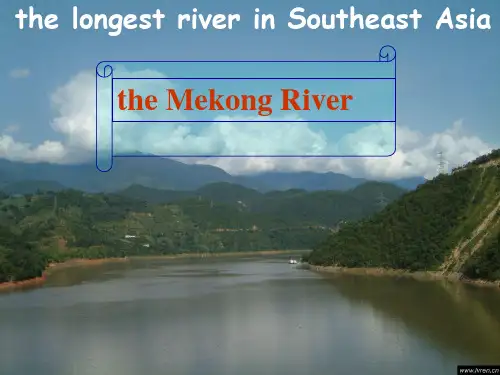
![人教版高中英语必修一Unit3JourneyDownTheMekong教案[2020年最新]](https://uimg.taocdn.com/4a5eb2ac763231126fdb1131.webp)
Unit 3 Reading - Journey down the Mekong 教案Homework: fill in the blanksTable 1.Learning strategy 1.__________________________________________________ Table 2.CountriesPronunciations MeaningsMyanmarLaosThailandCambodiaVietnam Learning strategy 2.__________________________________________________ Table 3. Group the words and expressions.like, dislike, agree, disagree, persuade, change one ’s mind, be fond of, care about, shortcoming, make up one ’s mind, determined, give in, stubborn.Positive Negative Neutral (中立的)Learning strategy 3.__________________________________________________Words I know(similar/related)New wordsjourneyschedulecycle1.altitude ____________2.valley______________3.glacier_____________4.rapids_____________5.waterfall____________6.delta_______________7.plain (n.)_______________8.meander (v.)_______________School: Furen Secondary SchoolClass: Grade 10, Class 2Teacher: Lizhi ZuoTeaching material: Reading---Journey down the MekongTeaching objectives:By the end of the lesson,1.all students can get the main idea and details about the passage by finishing different tables.2.most students can speak out some learning strategies(学习策略) in reading comprehension with the help of the teacher.3.some students can make a plan to help Wang Kun and Wang Wei out.Teaching procedures:Procedures Time Teacher’sactivity Students’activityPurposeStage 1. Check the homework 3’Ask studentsthe learningstrategy forTable 1,2,3.Answer thequestions.Let students beaware of the learningstrategy 1,2,3.Stage 2. Pre-reading 2’Ask students topredict themain ideaaccording tothe key wordsin table 1,2,3.Predict the mainidea.Let students beaware of the learningstrategy 4.Stage 3. While-reading 3’Ask students toskim thepassage tomatch the tableand check theirprediction.Skim the passageand finish task 3.Let students beaware of the learningstrategy 5.5’Ask students toscan theparagraph 1 todo task 4.Scan paragraph 1and finish task 4.Let students beaware of the learningstrategy 6.5’Ask students toscan paragraph2 and do task 5.Scan paragraph 2and finish task 5.Let students beaware of the learningstrategy 7.5’Ask students toscan paragraph3 and do task 6.Scan paragraph 3and finish task 6.Let students beaware of the learningstrategy 8.Stage 4. Post-reading 13’Ask students todo task 7-makea plan.Work in a group tofinish task 7.Let students beaware of the learningstrategy 9,10 andknow how to make aplan to help WangKun and Wang Weiout.4’Ask students toevaluate thelearningstrategieswe’vementioned inthis lesson.Evaluate andchoose the mostimpressive onesand leastimpressive ones.Check whetherstudents have beenaware of the learningstrategies.Ask students todo homework.Finish thehomework.Consolidate whatthey’ve learned.Unit 3 Reading - Journey down the Mekong 导学案Learning objectives:By the end of the lesson, I will be able to:4.speak out some learning strategies(学习策略) in reading comprehension with the help of the teacher.5.get the main idea and details about the passage by finishing different tables.6.make a plan to help Wang Kun and Wang Wei out.I. Pre-reading.Task 1. Check homework.Learning strategy 1:_________________________________________________ Learning strategy 2:_________________________________________________ Learning strategy 3:_________________________________________________ Task 2. Predict the main idea of the passage.Learning strategy 4:_________________________________________________ II. While-reading.Task 3. Read the passage quickly to match the table and get the main idea to check our prediction.Paragraph Key words1 Solution to geography2 difficulties3 motivationLearning strategy 5:__________________________________________________Time Incidents(事件)Since middle school Wang Kun and his sister Wang Wei have dreamed about____________________.Task 4. Read para.1 carefully and fill in the blanks.Learning strategy 6:__________________________________________________ Task 5. Read para.2 to check the difficulties and the ways to solve them.Difficulties Solutions1.Wang Kun can't communicate well withWang Wei because Wang Wei is __________________.Wand Kun chose to ___________2.They know a little about the geography ofthe river, for example, its source is in____________, and it begins at an altitude of________________,so the air would be_____________ and the weather would be__________.Learning strategy 7:__________________________________________________ Task 6. Read para.3 to check the geography of the river.PlacesFeatures(特征) It begins in Qinghai Province . It is ________, and the wateris___________.It passes t hrough valleys across western Yunnan Province.It moves quickly andbecomes_________. It enters wide valleys . It becomes a ___________.It enters Southeast Asia,meanders through hills and valleys to the plains . It becomes______________andits pace _____________ and it makes______________.It enters the South China Sea .Not mentioned. Learning strategy 8:__________________________________________________Two years agoNot only did Wang Wei buy a mountain bike, but also she __________(one word) Wang Kun to buy one. Last yearWang Wei visited her cousins who grew up in western Yunnan Province near ________________. Out of China, it is called ____________________. After graduationThey decided to ___________(one word) along the Mekong River. And the journey crosses 6 countries: China __________,_________,____________,____________, _______________. Now Wang Wei is planning their ___________(one word) forthe journey ___________(one word) the Mekong.III. Post-reading.Task 7. Make a plan of one country along the Mekong River to help Wang Kun and Wang Wei out. (Group work)A Journey Plan in_______________Elements PreparationsTimeBudget(预算)GeographyClothesCultural differencesNoYes nguage:2. Currency(货币):3. Customs:4.5.6.....OthersLearning strategy 9:__________________________________________________ Learning strategy 10:__________________________________________________Task 8. Evaluate the learning strategies we’ve mentioned in this lesson.Learning strategies we've mentionedS1: build the connection between what I'velearned and what I will learn.S2: know how to use the dictionary.S3: try to understand and remember the words by grouping them. S4: predict the main idea according to the key words.S5: skim(略读) the passage to get the main idea. S6: scan(扫读) the passage to get the details.S7: overcome the difficulties in communication in different ways. S8: sort out(整理) the information by tables and key words.S9: get information from our textbook(p55)and the material from the Internet.S10: learn and share by cooperation.Evaluation:1.The most impressive ones (3)________________________________.2.The least impressive ones (3)________________________________.Homework.(Choose one)1.Make a poster to show the whole plan of the journey down the Mekong to help Wang Kun and Wang Wei out.2.The coming winter holiday, I want to travel to Canada, could you help me make a plan for the journey?。
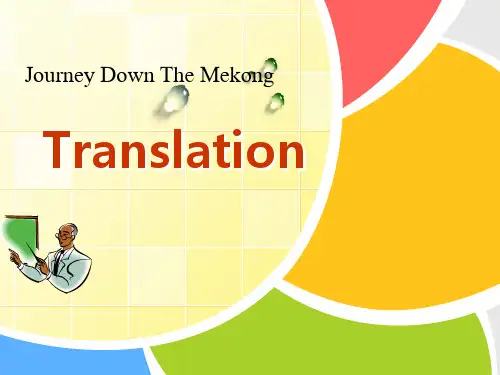
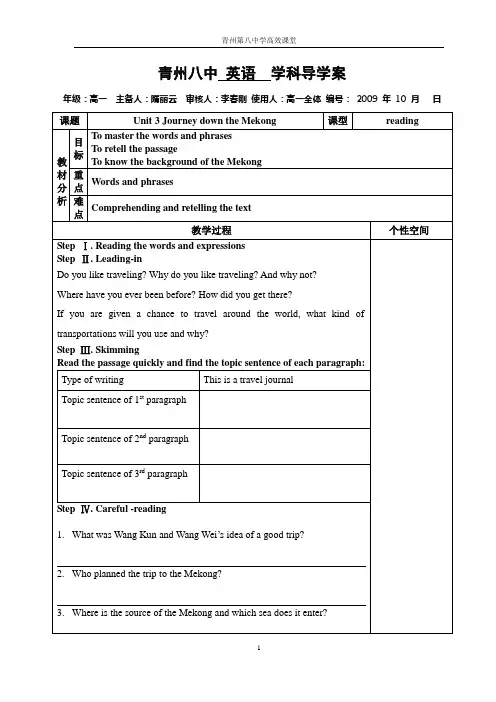
青州八中英语学科导学案年级:高一主备人:隋丽云审核人:李春刚使用人:高一全体编号: 2009 年 10 月日课题Unit 3 Journey down the Mekong 课型reading教材分析目标To master the words and phrasesTo retell the passageTo know the background of the Mekong重点W ords and phrases难点Comprehending and retelling the text教学过程个性空间Step Ⅰ. Reading the words and expressionsStep Ⅱ. Leading-inDo you like traveling? Why do you like traveling? And why not?Where have you ever been before? How did you get there?If you are given a chance to travel around the world, what kind of f transportations will you use and why?Step Ⅲ. SkimmingRead the passage quickly and find the topic sentence of each paragraph: Type of writing This is a travel journalTopic sentence of 1st paragraphTopic sentence of 2nd paragraphTopic sentence of 3rd paragraphStep Ⅳ. Careful -reading1.What was Wang Kun and Wang Wei’s idea of a good trip?2.Who planned the trip to the Mekong?3.Where is the source of the Mekong and which sea does it enter?4.What can you see when you travel along the Mekong?5.What difficulties did Wang Kun and Wang Wei find about their journey?6.What do you think about Wang Kun and Wang Wei?Step Ⅴ. Retelling the story in the third personWang Kun and his sister Wang Wei have taking a great bike trip their middle school days. After from college, they to cycle along the Mekong River. Wang Wei also got their cousins Dao Wei and Yu Hang interested in , too. It was Wang Wei first had the ideas to along the Mekong River from to . Now she is planning their for the trip.Wang Kun his sister but she has one serious . She was a girl. she didn’t know the best way of getting to places, she that she the trip properly. She doesn’t details. So Wang Kun told her that the of the Mekong River was in Qinghai. She gave Wang Kun a look-the kind that said she wouldn’t. When Wang Kun told Wang Wei that their would begin at an of more than 5000 meters, she seemed to be excited about it. She also thought that it would be an interesting . Once she has , nothing can change it. Her brother couldn’t her. At last, her brother had to .Before the trip, they went to the library, where they found a large with good maps. From the atlas, they learnt more information about the Mekong River.Step Ⅵ. Retell the story according to the key words and phrases.Wang Kun and his sister…middle school…after graduating…got the chance to…thought of the idea…cycle…the Mekong River…got sb. interestedin…journey…begin at an altitude of…change one’s mind…atlas…in the libraryStep Ⅶ. Homework1. Read the text again and review the meaning and usage of the key words and phrases:transport, prefer, disadvantage, fare, flow, ever since, persuade, cycle, graduate, schedule, be fond of, shortcoming, stubborn, organize, care about, determined, change one’s mind, journey, altitude, make up one’s mind, give in, valley, pace, bend2. Write the passage down in the notebook.课堂总结。
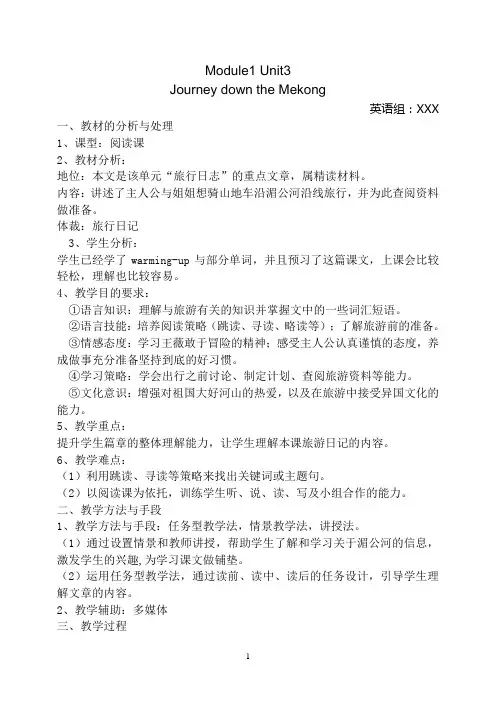
Module1 Unit3Journey down the Mekong英语组:XXX一、教材的分析与处理1、课型:阅读课2、教材分析:地位:本文是该单元“旅行日志”的重点文章,属精读材料。
内容:讲述了主人公与姐姐想骑山地车沿湄公河沿线旅行,并为此查阅资料做准备。
体裁:旅行日记3、学生分析:学生已经学了warming-up与部分单词,并且预习了这篇课文,上课会比较轻松,理解也比较容易。
4、教学目的要求:①语言知识:理解与旅游有关的知识并掌握文中的一些词汇短语。
②语言技能:培养阅读策略(跳读、寻读、略读等);了解旅游前的准备。
③情感态度:学习王薇敢于冒险的精神;感受主人公认真谨慎的态度,养成做事充分准备坚持到底的好习惯。
④学习策略:学会出行之前讨论、制定计划、查阅旅游资料等能力。
⑤文化意识:增强对祖国大好河山的热爱,以及在旅游中接受异国文化的能力。
5、教学重点:提升学生篇章的整体理解能力,让学生理解本课旅游日记的内容。
6、教学难点:(1)利用跳读、寻读等策略来找出关键词或主题句。
(2)以阅读课为依托,训练学生听、说、读、写及小组合作的能力。
二、教学方法与手段1、教学方法与手段:任务型教学法,情景教学法,讲授法。
(1)通过设置情景和教师讲授,帮助学生了解和学习关于湄公河的信息,激发学生的兴趣,为学习课文做铺垫。
(2)运用任务型教学法,通过读前、读中、读后的任务设计,引导学生理解文章的内容。
2、教学辅助:多媒体三、教学过程Step1: Lead inAsk some students to present their dialogue.(The homework of last class)【设计说明】采用对话形式导入,营造出宽松的学习气氛,为学生全面的课堂参与作了铺垫。
Step2: Pre-readingShow students some pictures and maps to know more about the Mekong river, its two names and the route it flows out of China.1. Names: Lancang River and Mekong River2. Route: China-Myanmar-Laos-Thailand-Cambodia-Vietnam-South China sea 【设计说明】利用图片来了解湄公河,为课文第三段做铺垫,同时,激发了学生的兴趣和好奇心。

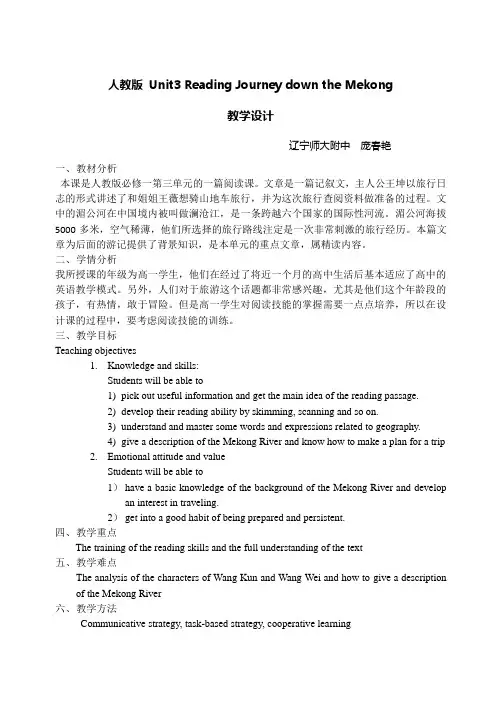
人教版Unit3 Reading Journey down the Mekong教学设计辽宁师大附中庞春艳一、教材分析本课是人教版必修一第三单元的一篇阅读课。
文章是一篇记叙文,主人公王坤以旅行日志的形式讲述了和姐姐王薇想骑山地车旅行,并为这次旅行查阅资料做准备的过程。
文中的湄公河在中国境内被叫做澜沧江,是一条跨越六个国家的国际性河流。
湄公河海拔5000多米,空气稀薄,他们所选择的旅行路线注定是一次非常刺激的旅行经历。
本篇文章为后面的游记提供了背景知识,是本单元的重点文章,属精读内容。
二、学情分析我所授课的年级为高一学生,他们在经过了将近一个月的高中生活后基本适应了高中的英语教学模式。
另外,人们对于旅游这个话题都非常感兴趣,尤其是他们这个年龄段的孩子,有热情,敢于冒险。
但是高一学生对阅读技能的掌握需要一点点培养,所以在设计课的过程中,要考虑阅读技能的训练。
三、教学目标Teaching objectives1.Knowledge and skills:Students will be able to1)pick out useful information and get the main idea of the reading passage.2)develop their reading ability by skimming, scanning and so on.3)understand and master some words and expressions related to geography.4)give a description of the Mekong River and know how to make a plan for a trip2.Emotional attitude and valueStudents will be able to1)have a basic knowledge of the background of the Mekong River and develop an interest in traveling.2)get into a good habit of being prepared and persistent.四、教学重点The training of the reading skills and the full understanding of the text五、教学难点The analysis of the characters of Wang Kun and Wang Wei and how to give a description of the Mekong River六、教学方法Communicative strategy, task-based strategy, cooperative learning七、教学过程【体现教学目标达成、教学重难点突破、教法学法说明】八、 板书设计。
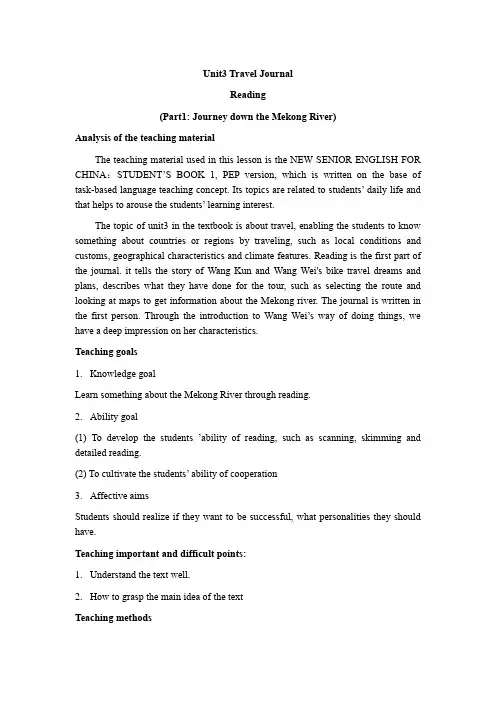
Unit3 Travel JournalReading(Part1: Journey down the Mekong River)Analysis of the teaching materialThe teaching material used in this lesson is the NEW SENIOR ENGLISH FOR CHINA:STUDENT’S BOOK 1, PEP version, which is written on the base of task-based language teaching concept. Its topics are related to students’ daily life and that helps to arouse the students’ learning interest.The topic of unit3 in the textbook is about travel, enabling the students to know something about countries or regions by traveling, such as local conditions and customs, geographical characteristics and climate features. Reading is the first part of the journal. it tells the story of Wang Kun and Wang Wei's bike travel dreams and plans, describes what they have done for the tour, such as selecting the route and looking at maps to get information about the Mekong river. The journal is written in the first person. Through the introduction to Wang Wei’s way of doing things, we have a deep impression on her characteristics.Teaching goals1.Knowledge goalLearn something about the Mekong River through reading.2.Ability goal(1) To develop the students ’ability of reading, such as scanning, skimming and detailed reading.(2) To cultivate the students’ ability of cooperation3.Affective aimsStudents should realize if they want to be successful, what personalities they should have.Teaching important and difficult points:1.Understand the text well.2.How to grasp the main idea of the textTeaching methodsTask-based language teachingTeaching aids: a computer & a projectorTeaching proceduresStep ⅠLead In(1minute)T: Q1: Have you visited any river?Q2: How many great rivers do you know?Q3: If you can travel down only one of them, which one would you choose? Why?Show pictures and maps of some famous rivers in China, students tell their names. (The Yellow River, the Changjiang River, the Pearl River and the Mekong River)Step ⅡPre-reading(2 minutes)T: Have you visited the Mekong River? If no, let’s learn something about it.1. Show a map of the Mekong River and the brief introduction of it. Ask them:Can you list the countries that the Mekong River flows through?Step ⅢReading(26minutes)In this step, get the students to read the text and finish some tasks.Fast-reading:Task1: Scan the text quickly, and then answer some questions (10minutes):Q1. What is the main idea of each paragraph?Q2.where is the source of the Mekong River and which sea does it enter?Evaluation way: oral evaluation made by students.Detailed-readingTask2:The whole read paragraph 1 loudly and find out the answer of the following questions: (4minutes)Q1、What is Wang Kun and Wang Wei’s idea of a good trip?Q2、Who are Dao Wei and Yu Hang?Q3、Who plans the trip to the Mekong?Evaluation way: oral evaluation made by teacher.Task3:Listen to the tape of paragraph 2 carefully, and then finish the True orFalse questions: (4minutes)1. Wang Wei thinks that her way is the proper way.2. Wang Wei is a stubborn and careful girl.3. The journey is difficult because it begins at an altitude of more than 5,000 meters, where it is hard to breathe and very cold.Evaluation way: oral evaluation made by teacher.Task4:Role-Play. Suppose that one student is guide, the others are foreigners going to travel along the Mekong River, please the guide to introduce to the foreigners about what they can see during the journey. Read paragraph 3 carefully first. (4minutes).Evaluation way: oral evaluation made by students.Task5: Consolidation: retell the passage and fill in the blanks (4minutes)Wang Kun and Wang Wei had ________ (dream) of taking a bike trip for a long time. After they graduated _____ college, they were ___________ (determine) to cycle along the Mekong River. In order to do the trip __________ (proper), they went to the library and found a large atlas with good _____(map) in it. After a careful study to the maps, they found the source of the river and made up ______ mind to begin their journey ____ an altitude of 5,000 meters. During their journey, they could enjoy the ________(beauty) scenery of glaciers, deep valleys, waterfalls and plains.Evaluation way: oral evaluation made by teacher.Step IV Post-reading (10minutes)Task 6:Make comparison (5minutes)An attitude is what a person thinks about something. Make lists of Wang Wei’s and Wang Kun’s similar and different attitudes about the trip.Evaluation way: oral evaluation made by groups.Task 7: Debate (5minutes)Which character do you like, Wang Kun or Wa ng Wei? Why?Evaluation way: oral evaluation made by teacher.Step V Homework (1minute)1. Read the text again.2. Write a passage about your own travel experience.。
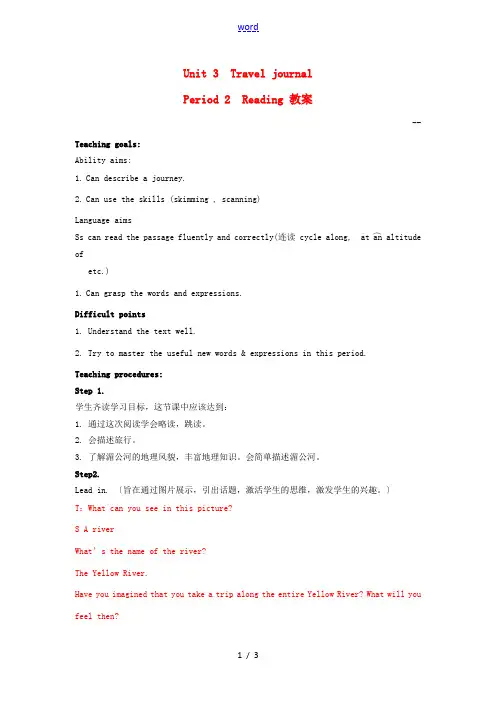
︵ ︵ Unit 3 Travel journalPeriod 2 Reading 教案--Teaching goals:Ability aims:1. Can describe a journey.2. Can use the skills (skimming , scanning)Language aimsSs can read the passage fluently and correctly(连读 cycle along, at an altitudeofetc.)1. Can grasp the words and expressions.Difficult points1. Understand the text well.2. Try to master the useful new words & expressions in this period.Teaching procedures:Step 1.学生齐读学习目标,这节课中应该达到:1. 通过这次阅读学会略读,跳读。
2. 会描述旅行。
3. 了解湄公河的地理风貌,丰富地理知识。
会简单描述湄公河。
Step2.Lead in. 〔旨在通过图片展示,引出话题,激活学生的思维,激发学生的兴趣。
〕 T :What can you see in this picture?S A riverWhat ’s the name of the river?The Yellow River.Have you imagined that you take a trip along the entire Yellow River? What will you feel then?S1.May be I will feel excited.S2.Surprised by its beauty....T: Just now, most of you use many different words to describe your feelings , such as, excited, surprise..., In a word, you imagine the trip must be exciting. It is so accidental that a student named Wang Kun is planning to take a trip along the MekongRiver. Doyou know where the MekongRiver is?S. Yes.T: Goood, Yes you have the information about MekongRiver. Please tell me something about it..Yellow River→ Mekong RiverA short introduce the MekongRiver.Now, you must want to know what Wang Kun is planning for the trip. Let’s e to the passage.Step3 Reading〔设计skimming和scanning旨在引导学生快速浏览文章,从总体上把握文章的框架结构和主题结构。
高一英语必修一Unit 3课文翻译Unit 3 Travel journalReadingJOURNEY DOWN THE MEKONG沿湄公河而下的旅程PART 1 THE DREAM AND THE PLAN第一部分梦想与计划My name is Wang Kun. Ever since middle school, my sister Wang Wei and I have dreamed about taking a great bike trip.我的名字叫王坤。
从高中起,我姐姐王薇和我就一直梦想作一次伟大的自行车旅行。
Two years ago she bought an expensive mountain bike and then she persuaded me to buy one.两年前,她买了一辆昂贵的山地自行车,然后还说服我买了一辆(山地车)。
Last year, she visited our cousins, Dao Wei and Yu Hang at their college in Kunming.去年她去看望了我们的表兄弟——在昆明读大学的刀卫和宇航。
They are Dai and grew up in western Y unnan Province near the Lancang River, the Chinese part of the river that is called the Mekong River in other countries.他们是傣族人,在云南省西部靠近澜沧江的地方长大,湄公河在中国境内的这一段叫澜沧江,在其他国家(境内)叫湄公河。
Wang Wei soon got them interested in cycling too.很快,王薇使表兄弟也对骑车旅游产生了兴趣。
After graduating from college, we finally got the chance to take a bike trip.大学毕业以后,我们终于有了机会骑自行车旅行。